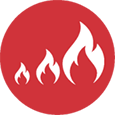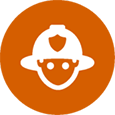Can I light a fire?
To find out if you can light a fire, you need to know your area, know your fire class, and know the rules you need to follow.
Know your area
 The CRD provides fire protection services in many Electoral Area communities. Municipalities are responsible for provision of fire protection through their local fire departments.
The CRD provides fire protection services in many Electoral Area communities. Municipalities are responsible for provision of fire protection through their local fire departments.
Know your fire class

A Campfire is a recreational or ceremonial fire smaller than a 0.5 meter by a 0.5 meter in size.
A Category 2 Fire is for burning debris in 1 to 2 piles smaller than 2 meters high by 3 meters wide.
A Category 3 Fire is any fire larger than Category 2.
Solid Fuel Appliances include outdoor wood-burning barbecues, chimineas, pizza ovens, hot tubs, and food smokers.
Incinerators include any metal or masonry container used for burning, such as a burn barrel.
Know the rules

All fires require building setbacks, venting conditions, supervision, a fuel break, access to water and handtools, and more.